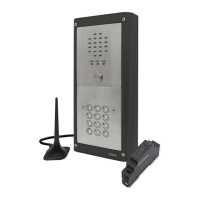66250675-EN - V1.0 - 05/09/17
50
4000 Series Vandal Resistant GSM - Technical Manual
4000 Series Vandal Resistant GSM Audio Intercom with Proximity Facility
USING A PROXIMITY READER ONLY APPLICABLE IF AN ART.VR4KPPM READER IS CONNECTED
In order for the Art.VR4KPPM proximity reader to work correctly it must rst be connected to the GSM intercom using the 'plug-in'
proximity harness as shown in Fig.17 on page 22 and the proximity reader enabled (also refer to enable proximity reader EPR notes
and proximity bytes PBY notes on page 46 for correct setup).
Fobs/cards must also be stored in the GSM intercom following the store a fob or card FOB programming notes on pages 46 and
47 (programming fobs/cards can also be carried out using the GSMSK PC software, more information on this can be found in the
technical manual GSMSK-66251720-EN-V1-3 (or later version).
PRESENTING A FOB/CARD TO THE READER
When the system is in standby all the LED’s (speak, busy and
open) on the front of the GSM intercom will be switched OFF.
The amber LED on the reader will ash at 5 second intervals to
indicate there is power on ther reader, see Fig.76.
ACCESS GRANTED
To operate the GSM relay present a programmed fob/card to
the proximity reader. The busy LED on the GSM intercom will
ash once, the open LED will switch ON and the GSM will emit
a single beep at 1 second intervals for the duration of the relay
time RLT. The access granted LED (middle green LED on the
reader) will also switch ON for the duration of the GSM relay
time and the reader will emit a single beep, see Fig.77.
ACCESS DENIED
If a fob/card is presented to the reader that has not been
programmed then the busy LED on the GSM intercom will
switch ON for approximately 2 seconds and the GSM will emit
a long single beep. The access denied LED (right red LED on the
reader) will also switch ON for approximately 2 seconds and the
reader will emit a single beep, see Fig.78. The GSM’s relay will
not operate.
IMPORTANT NOTE: If the proximity reader has not been
enabled and a fob/card is presented the reader will not respond
(however the amber LED will still continue to ash at 5 second
intervals as normal).
Fig. 76
Fig. 77
Fig. 78
Additional user operations can be carried out using the commands and/or SMS text messages shown in the user command tables
on page 51.
SPEAK BUSY OPEN
Proximity Reader LED’s GSM module LED’s
SPEAK BUSY OPEN
Proximity Reader LED’s GSM module LED’s
SPEAK BUSY OPEN
Proximity Reader LED’s GSM module LED’s
System Operation

